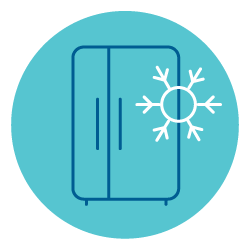ARTICLES > NOURISH
HOW TO SET UP A GLUTEN-FREE KITCHEN
From pantry organisation to your first shop and avoiding cross-contamination, here’s how to give your kitchen a gluten-free makeover.
If you’ve been diagnosed with coeliac disease, you’ll need to start a gluten-free diet as soon as possible – and getting your kitchen in order is one task that will make meal prep so much easier. There’s no need to make your entire kitchen a gluten-free zone or make the whole family overhaul their diet, but here are the important changes that will help reduce the risk of cross contamination, or accidentally eating gluten.
-

COLOUR CODE AND LABEL YOUR FOOD CONTAINERS
Remember, gluten-free and wheat flour look identical in a container if they are not in their original packaging. Keep all gluten-free food in a container with a blue lid or clearly mark storage jars with a ‘gluten free’ sticker to help make identifying gluten-free items easy, even for a small child.
-

SORT YOUR PANTRY AND FRIDGE
Look in your pantry and work out what items you currently have that are gluten free. You might want to download Coeliac Australia’s app, which features a useful ingredient list for this task. You may be amazed by how many products you already have!
Label reading is a skill you need to learn. The more practice you have, the faster and more confident you will become.
Put all your gluten-containing foods on a separate shelf. You may find it easier to give away pantry essentials that contain gluten, such as soy sauce, stocks and sauces. Use gluten-free versions of these products to make the evening family meal gluten free so that there’s no need to cook multiple meals.
Tip: Discourage double dipping to prevent contamination of shared condiments. Use a spoon to scoop out the condiment on to your plate and then spread from this. If it proves too hard to keep the condiments clean, it may be necessary to have separate, clearly marked ‘gluten free’ containers or jars.
-

FIRST GLUTEN-FREE GROCERY SHOP
It is easy to go overboard during your first grocery shop and buy everything that is marked gluten free. Start by purchasing the essentials to replace the gluten-containing items you have identified when sorting your pantry. This may include bread, cereal, pasta, sauces and flour. Gluten-free bread is a different texture from wheat bread, so you may need to experiment with different brands of breads and cereals before you find one you like. Our advice? Don’t buy in bulk during your first shop.
-

BE ADVENTUROUS WITH YOUR COOKING
Now that your kitchen is sorted, it’s time to cook gluten free! Start by looking at the meals you already prepare – some recipes may already be gluten free, or with some minor tweaking and substitutions could easily be suitable. For example, simply using gluten-free soy sauce could make your Monday night stir-fry coeliac friendly. This is a great opportunity to experiment with new gluten-free recipes – and you can start right here at Gluten Free Living.
-

BE A SAVVY SHOPPER
When shopping, look for the Coeliac Australia Endorsement logo, which tells you the product is safe – or check Coeliac Australia’s list of endorsed products.
-

Read through the ingredient list looking for any mention of wheat, rye, barley or oats – if any ingredient is derived from these grains, then it will tell you. No mention of these grains means the product is safe. If one of these grains is mentioned, put the product back unless the gluten derived ingredient is wheat glucose syrup, caramel colour (wheat) or dextrose (wheat) – these ingredients are suitable, even though they mention wheat.
And remember, fresh produce is naturally gluten free, along with fresh, unprocessed meat and poultry, even if the animal was grain fed. Do check for stuffings and marinades – in which case you should carefully read the ingredients.
AROUND THE HOUSE
Check your medicine cabinet. Some medicines and tablets contain gluten. Gluten in medications must be declared when present at levels >20ppm (either on the packaging or in the Consumer Medicines Information sheet included with prescribed medication). If you’re unsure, check with your pharmacist or GP.
Some cosmetic, skin and hair care products contain wheat or oat-derived ingredients. As it is only gluten that is eaten that damages the small bowel, products containing gluten used on the skin or hair are safe for people with coeliac disease to use.
STEP SEVEN: REDUCE THE RISK OF CROSS CONTAMINATION
It is safe to:
- Wash all utensils, plates, etc. in the same washing-up water.
- Cook gluten and gluten-free items in the same oven. Gluten cannot contaminate food through air or steam.
- Use the same chopping board for both gluten-containing and gluten-free foods. Prepare the gluten-free food first or wipe down the chopping board with a clean cloth before chopping gluten-free food, so there is no risk of cross-contamination.
- Use a shared toaster (some prefer to use a separate toaster or toaster bags).
- Use one set of condiments, introducing a ‘single dip’ or ‘clean spoon’ policy to prevent contamination of the condiments.
To avoid contamination, do not:
- Use the same cooking water for both gluten-containing and gluten-free foods. For example, when cooking pasta, water used for gluten-containing pasta must be discarded and the pot cleaned before cooking gluten-free pasta. A better option is to cook both pastas at the same time in separate pots, using individual stirring utensils for each, or cook gluten-free pasta first.
READ THIS NEXT

WHAT TO DO IF YOU ACCIDENTALLY EAT GLUTEN
If you have a gluten sensitivity or coeliac disease, you might know straight away after an accidental gluten intake. Here’s how to ease your symptoms.

GLUTEN-FREE FOODS FOR GUT HEALTH
Can certain foods improve your gut health when you have coeliac disease? Get into the fascinating world of the human gut and the power of fermented foods.
See more















Some of these cross contamination things are issues I have heard other coeliacs definitely have problems with! No shared washing up water, no shared cutting boards and no shared appliances.
I wound like to have some education session run for staff to care for my new resident , who is coeliac and on strict Gluten Free diet
We are an OOSH and would like to be part of this, we only have 2 children at present however I’m gluten and dairy intolerant and live this life. I want all my staff to become aware of this allergy. We are changing our service to gluten free and have started the process of deleting most gluten product from our menu. Looking forward to keeping in contact with your association.